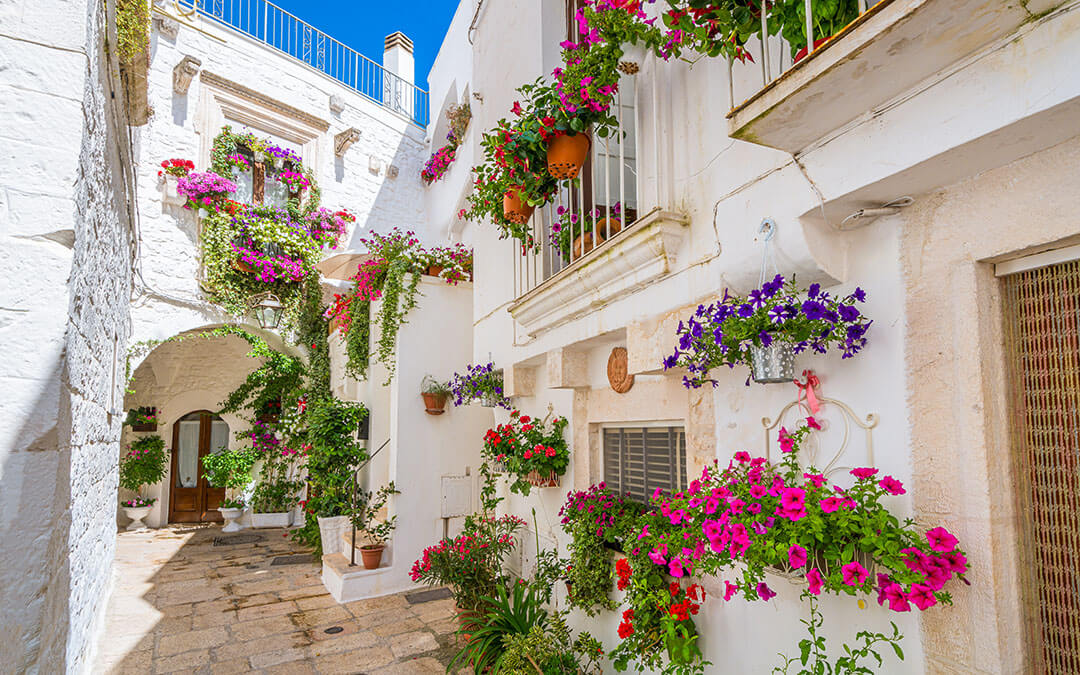
Villages
Enchanted villages, narrow streets, whitewashed historic centers. Apulian small villages are waiting to be discovered, first of all Cisternino, the village in which you stay.
Alberobello
20 km - about 20 Minutes by Car
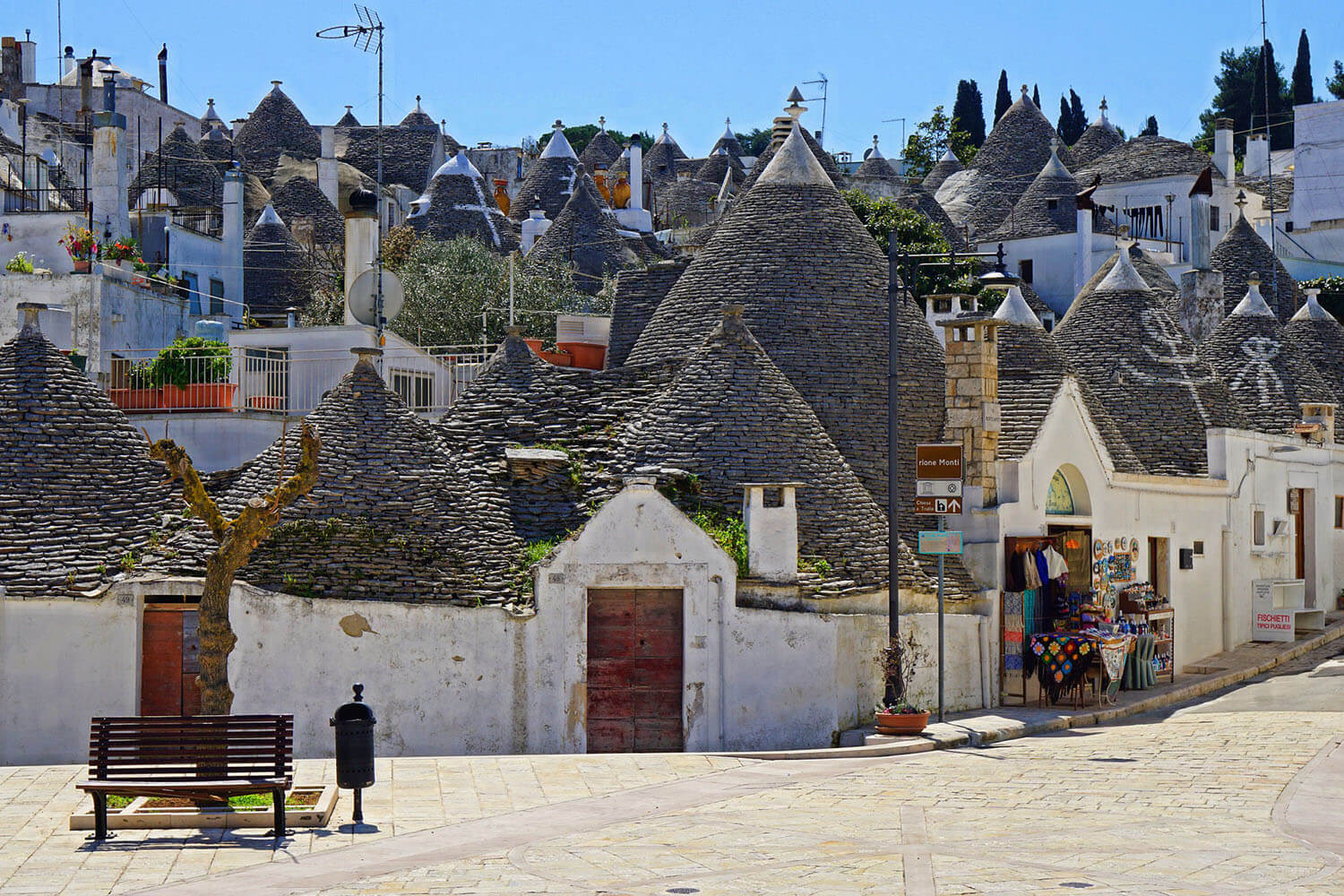
Alberobello is the city that opens the Itria Valley, the Valley of the Trulli. The trullo is the typical conical construction in dry stone, a characteristic symbol renowed in the world. Located on the hills of the southern Murgia, it is divided into the South area which preserves historical center as in a fairtale, and the North area as well as the new part of the city.
The famous Rione Monti branches off to the south, absolutely worth seeing. This is the most characteristic district of the city which has also become a UNESCO heritage site due to its building and historical uniqueness. Over a thousand trulli intersected by fifteen streets are the attraction of tourists from all over the world. Each trullo has a fascinating story that becomes magical when heard by the local inhabitants.
Wandering from one trullo to another, many of which today are used as shops and businesses, you can't help but stop to take the perfect photo of the sovereign trullo and the Siamese trulli. The Trullo Sovrano, an iconic monument of the city of Alberobello, represents the greatest architecture in the construction of the trullo both for its imposing size and for the walls that go from dry stone to the use of mortar. Externally it has a large facade with an arch on which a scene from Calvary is painted; internally there are 12 rooms some of which, smaller, obtained in the very thick walls. Over time the trullo has taken on various functions: home, apothecary, chapel for the relics of Saints Cosmo and Damiano. Today it is used as a museum for exhibitions.
The Trulli Siamesi, have two entrances, one per cone. The structure has a terraced conformation carved into the rock and has no windows. On the south-eastern side of the city, between one walk and another, you arrive at the Aia Piccola district. This is the most pristine spot in the city from commercial activities. Here there are the Courts such as the Corte di Giangiacomo and Pozzo Contino as well as courtyards or open spaces surrounded by walls on which the houses overlooked, and the trulli are left in their original state, giving suggestive views for lovers of photographs. Slso several churches such as the Church of Santa Lucia, the Sanctuary of SS. Medici, the Church of Sant’Antonio and the Church of the Carmine.
Tasting local specialties is unavoidable on a trip like this. The Alberobello cousine offers a variety of dishes starting from vegetables such as artichokes and country vegetables, to fish-based dishes such as tiella (rice, potatoes and mussels) to conclude to dishes such as roasted livers, orecchiette with simple tomato, puree or soup. broad beans, onion focaccia and olives. Egg-based meatballs are also typical. Many different tastes for every palate and also good reasons to visit Alberobello.
Locorotondo
15 km - about 15 Minutes by Car
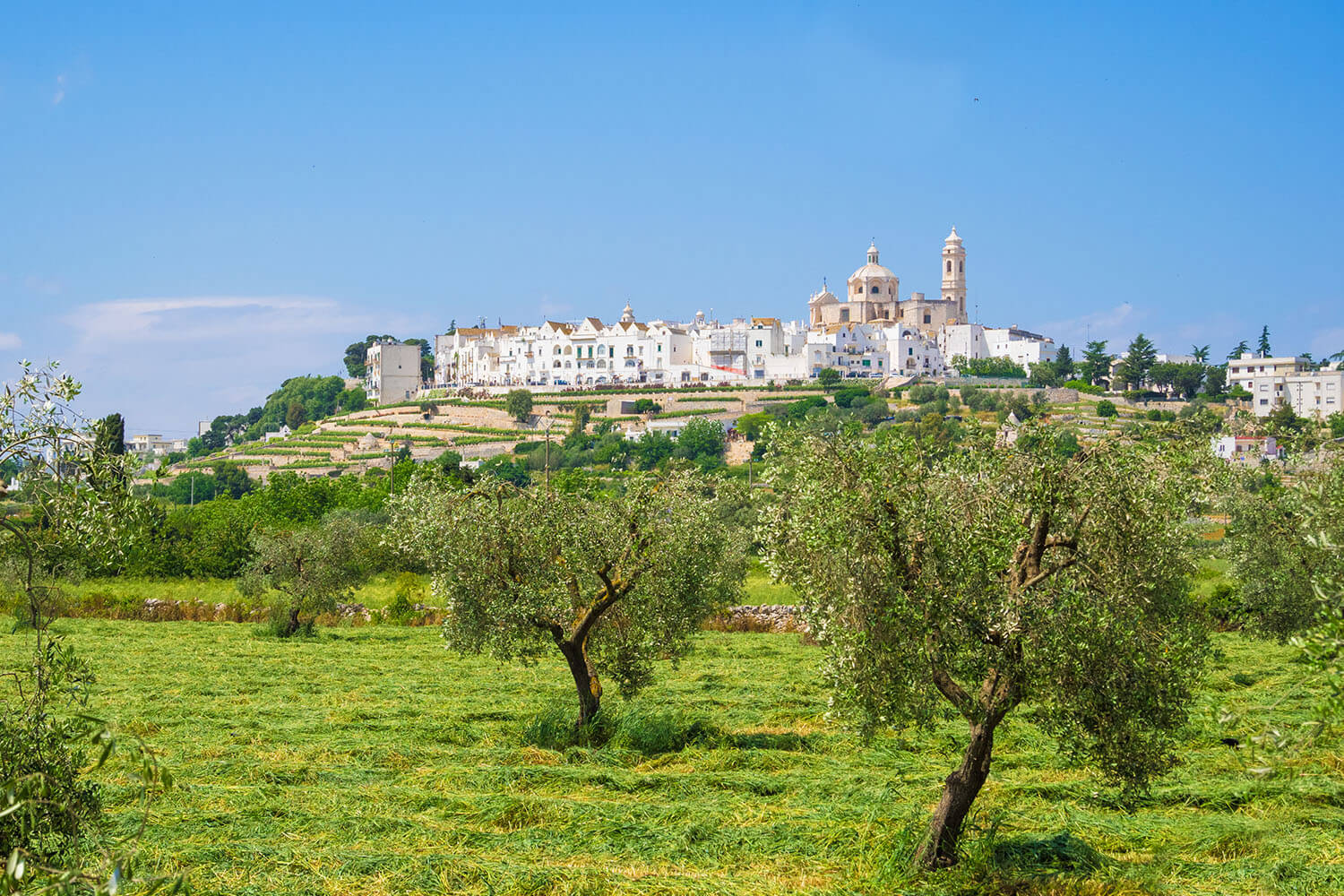
On the podium among the most beautiful villages in Italy, Locorotondo is another pearl of Puglia that extends into the enchanting landscape of the Valle d'Itria and the Valle dei Trulli. Locorotondo, which literally means round place, takes its name from the round shape of its historic center. Looking at it from above, the small white brick houses with sloping roofs form many concentric circles.
Surrounded by olive groves and wines, only 9 km far from Cisternino. The city can also be reached by bicycle for nature and bike lovers. The suggested things to do in Locorotondo are: organized bike tours (booking recommended), is a way to discover ancient streets inside the valley among fasctinating farms, trulli and farmhouses. You can visit the baroque Mother Church, the Church of the Madonna della Greca, the Church of the Holy Spirit, and ends in front of the balcony of the Belvedere from which you can admire the breathtaking view of the Murgia dei Trulli.
The journey can also continue on foot, tours will giude you in the ancient village to see the famous medieval historic center of Locorotondo. Developed on the top of the valley among narrow streets, flowered balconies, whitewashed houses.
Among the activities to do in Locorotondo, the food and wine tours are also not to be missed. Wandering among oil mills and cellars, it is possible to taste oil and white wine, two typical products of the city and of the Itria Valley strongly suited to olive growing and viticulture. Before leaving the city, a plate of lamb rolls called gnumerèdde suffuchète as well as the local specialty is a must.
Martina Franca
15 km - about 15 Minutes by Car
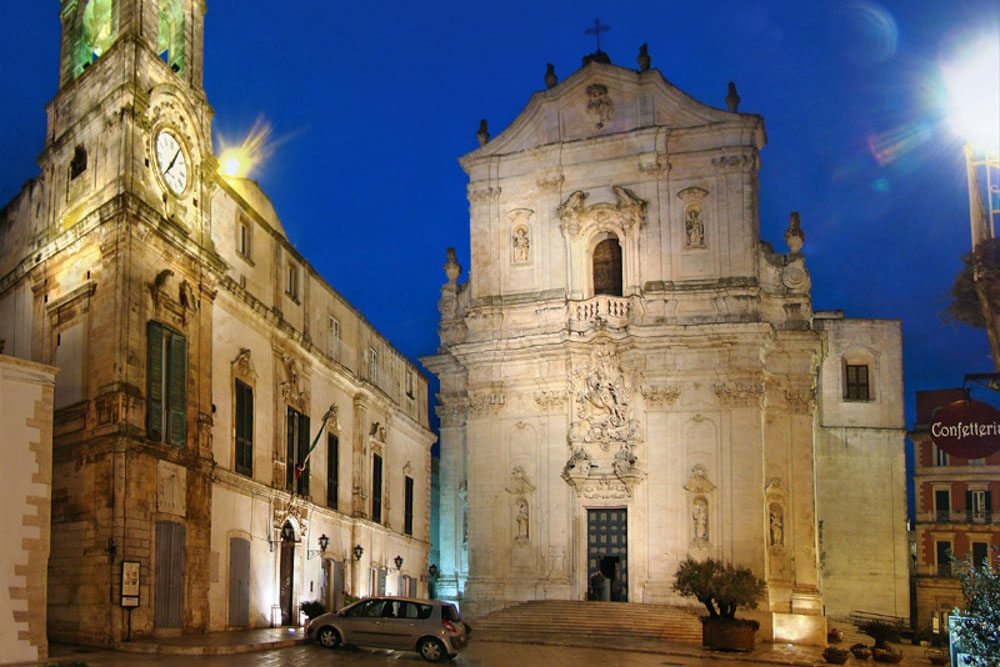
Martina Franca is one of the most fascinating and refined cities of the Itria Valley. Located on one of the last hills of the South-Eastern Murgia, between the Ionian and the Adriatic, it dominates the immense valley of olive trees, oak groves in which you find characteristic trulli and historic farmhouses.
The biggest city in terms of population in the Itria Valley is Martina Franca, it is an excellence for food wine and for the production of oil, wine, orecchiette, bocconotti, meat bowls, but above all for the Capocollo as well as typical salami . By an artistic / cultural point of view Martina is the stage for various events such as the Festival della Valle D’Itria, the Biennale della Memoria, the Festival del Cabaret, the White Week.
Thank to several events to which people take part and the majesty of churches and palaces (Baroque and Rococo style), Martina Franca is renowed as the city of Art and Culture. The maximum exponence of these architectural beauties can be admired in the historic centre where the Municipality organizes tours to discover the Palazzo Ducale periodically home to exhibitions, the noble palaces, the Basilica of San Martino and the numerous churches such as that of San Domenico, Sant'Antonio, of the Annunziata, of San Francesco D'Assisi flanked by enchanting glimpses given by narrow streets full of blind alleys with sharp corners. One of the characteristics of the historic centre of Martina Franca is also the pavement which, in some places, has remained the original stone one.
Especially during the summer and the spring period, bike tour is one of the most practised activity here in Martina Franca thanks to the unspoiled paths of the Itria Valley. There, the wineries organize wine tastings associated to local specialties. An unforgettable experience is drinking a glass of wine while the sun sets, in front of the valley of local native wines. Finally, for nature and adventure lovers you can have excursions through the Bosco delle Pianelle or the panoramic tour in a hot air balloon (lasting up to 3 hours) to admire the landscape of the Itria Valley from every corner.
Ostuni
10 km - about 10 Minutes by Car
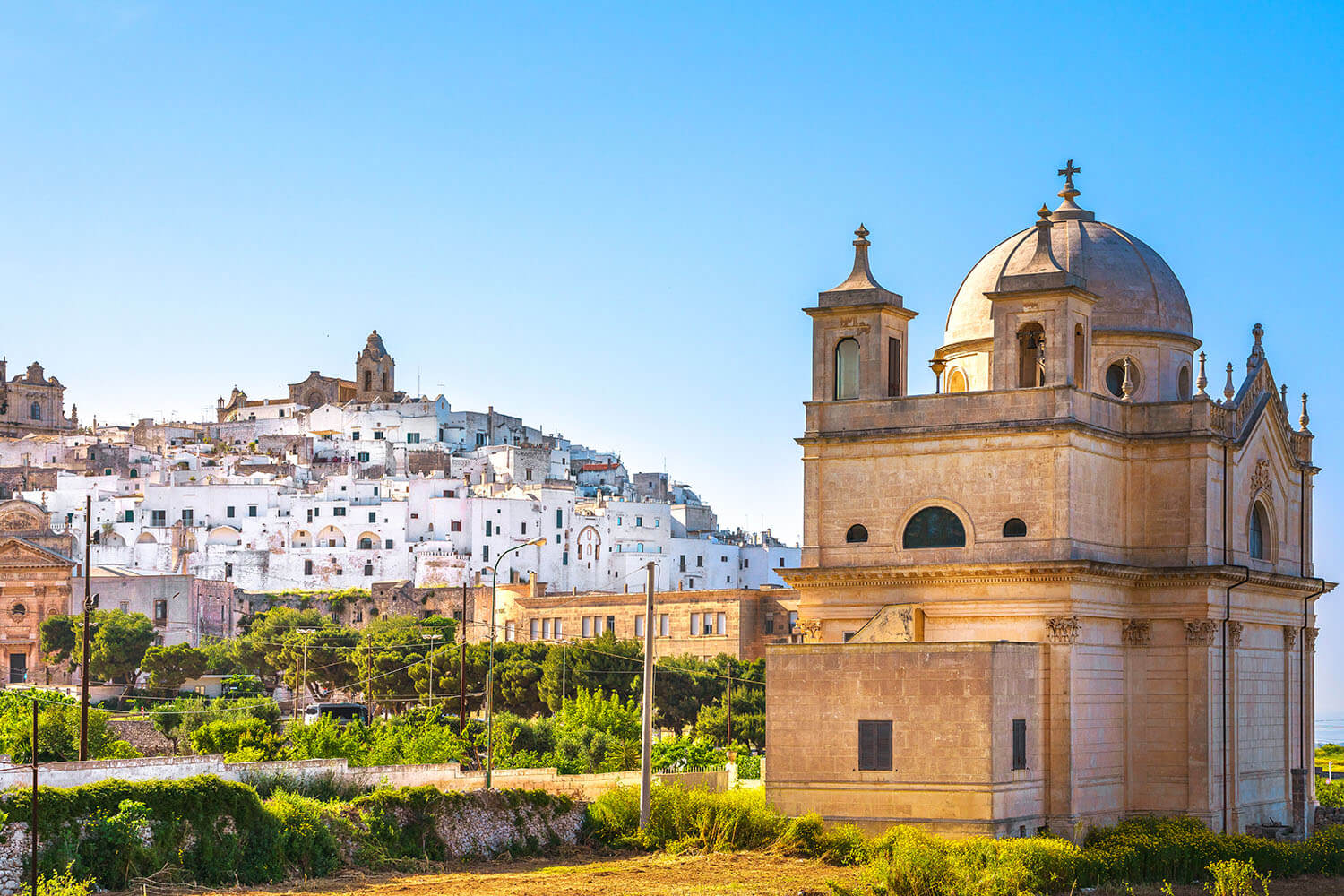
One of the most popular destinations for tourists, especially in the summer, is Ostuni, called the white city of the Itria Valley. The natural development along the top of the South-Eastern karst hills of the Murgia, the dominance of the valley that envelops the city in a green carpet of millenary olive and oak groves, the uniqueness of the medieval village intersected by houses, alleys, stairways, Aragonese bastions all in white lime, the proximity to the Adriatic coast visible from the various balconies and terraces that surround it, give Ostuni the nickname of city belvedere. A full-size postcard.
Finally, in the summer season, the seaside resorts such as Marina di Ostuni, the nature reserves of Torre Guaceto and Parco delle Dune Costiere or the beaches of Costa Merlata, Pilone, Torre Pozzelle are also within easy reach. Paradise sandy and rocky coves where you can indulge in moments of relaxation in the crystal clear waters of the Adriatic.
Visiting Ostuni means allowing yourself a day of touring. You can choose among different interests, here in the white city, there are several routes designed for tourists' need: walking tours as walking through the historic center to discover the Aragonese walls, the Cathedral of Santa Maria Assunta, the Diocesan Museum, up to arrive in Piazza della Libertà, the main place where dominate the Church of San Francesco and the Obelisk of Sant'Oronzo, patron saint of the city; tuk tuk tour (the characteristic ape car) to get involved in the tales of expert guides; Twizy tour (electric cars) for more adventurous routes from the city center down to the valley to discover hidden and uncontaminated paths where olive trees, oaks, trulli, rural homes and ancient farms are the setting scene. Ostuni is a city for all ages, many farmhouses, restaurants where you can taste the local specialties; popular for the young nightlife. Many are the places where you can meet and spend pleasant evenings still viewing the Itria Valley.
Villanova di Ostuni
Villanova di Ostuni is the small fraction of the eternal white city, it takes only 7 km from Ostuni. Overlooking the Adriatic coast, it is better known as Marina di Ostuni. This area extends from the Coastal Dunes Park to Pilone. In the middle you can stay on enchanting sandy beaches: Rosa Marina, Costa Merlata, Cala dei Ginepri which also represent the main tourist attractions of the area where families gather to have fun sipping a cool cocktail or relax in the paradisiacal waters of the cale.
Enchanted by the wonderful waters, one thing to see in Villanova di Ostuni is the ancient Angevin Castle from the fourteenth century used as a defense for enemy attacks located in front of the marina.
Costa Merlata
Costa Merlata is the stretch of coast that is part of the territory of Marina di Ostuni. The name derives from the particular conformation of its cliff: jagged and in the shape of a blackbird. The coast develops in a series of mixed inlets between sandy coves which, are well equipped with umbrellas, sunbeds and deck chairs; and rocky cliffs, mostly, for the more adventurous and diving enthusiasts.
In any case, the keyword is relax yourself, even in the high season, the coast is not so crowded and you can enjoy the clear and crystalline waters. Among the most sought-after beaches there is certainly the Darsena beach, which is more suitable for families and children thanks to a wider cove and to the to a low tide seawater. The beach is also equipped with access for the disabled, a restaurant, a kiosk, but above all with lifeguard assistance even if it remains a free beach. In short, everything you need to spend a quiet and relaxing day under the sun of Puglia.


